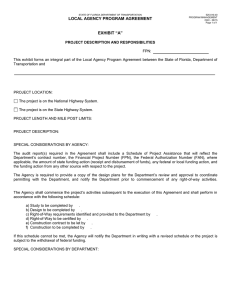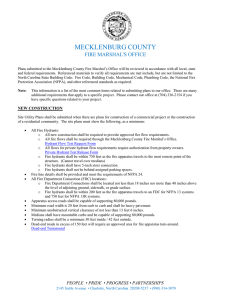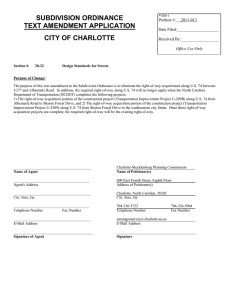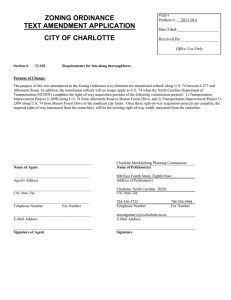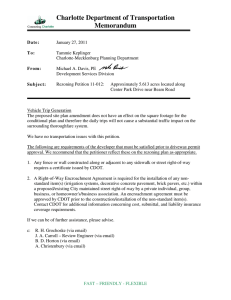section 3.0 specifications for drinking water distribution systems design
advertisement
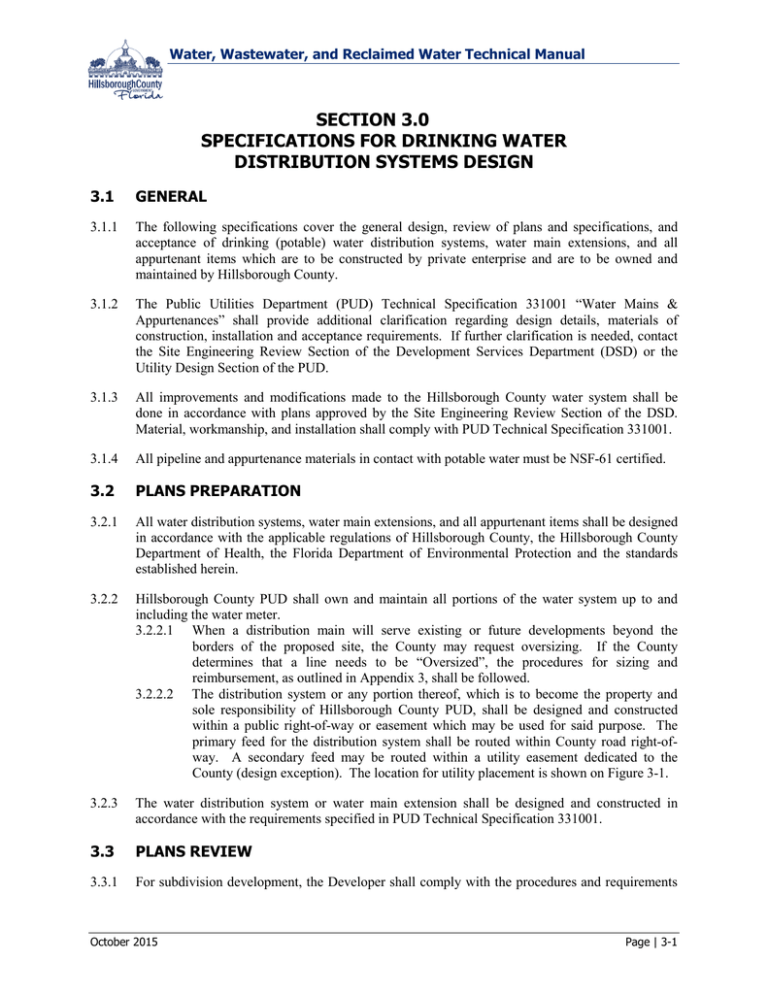
Water, Wastewater, and Reclaimed Water Technical Manual SECTION 3.0 SPECIFICATIONS FOR DRINKING WATER DISTRIBUTION SYSTEMS DESIGN 3.1 GENERAL 3.1.1 The following specifications cover the general design, review of plans and specifications, and acceptance of drinking (potable) water distribution systems, water main extensions, and all appurtenant items which are to be constructed by private enterprise and are to be owned and maintained by Hillsborough County. 3.1.2 The Public Utilities Department (PUD) Technical Specification 331001 “Water Mains & Appurtenances” shall provide additional clarification regarding design details, materials of construction, installation and acceptance requirements. If further clarification is needed, contact the Site Engineering Review Section of the Development Services Department (DSD) or the Utility Design Section of the PUD. 3.1.3 All improvements and modifications made to the Hillsborough County water system shall be done in accordance with plans approved by the Site Engineering Review Section of the DSD. Material, workmanship, and installation shall comply with PUD Technical Specification 331001. 3.1.4 All pipeline and appurtenance materials in contact with potable water must be NSF-61 certified. 3.2 PLANS PREPARATION 3.2.1 All water distribution systems, water main extensions, and all appurtenant items shall be designed in accordance with the applicable regulations of Hillsborough County, the Hillsborough County Department of Health, the Florida Department of Environmental Protection and the standards established herein. 3.2.2 Hillsborough County PUD shall own and maintain all portions of the water system up to and including the water meter. 3.2.2.1 When a distribution main will serve existing or future developments beyond the borders of the proposed site, the County may request oversizing. If the County determines that a line needs to be “Oversized”, the procedures for sizing and reimbursement, as outlined in Appendix 3, shall be followed. 3.2.2.2 The distribution system or any portion thereof, which is to become the property and sole responsibility of Hillsborough County PUD, shall be designed and constructed within a public right-of-way or easement which may be used for said purpose. The primary feed for the distribution system shall be routed within County road right-ofway. A secondary feed may be routed within a utility easement dedicated to the County (design exception). The location for utility placement is shown on Figure 3-1. 3.2.3 The water distribution system or water main extension shall be designed and constructed in accordance with the requirements specified in PUD Technical Specification 331001. 3.3 PLANS REVIEW 3.3.1 For subdivision development, the Developer shall comply with the procedures and requirements October 2015 Page | 3-1 Water, Wastewater, and Reclaimed Water Technical Manual set forth in Article VI, Part 6.02.00 of the County's Land Development Code. This includes the requirement for submittal, review, and approval of a preliminary plat of the proposed project and potable water master plan. The placement of appurtenances in Hillsborough County right-of-way shall be as required in the Utility Accommodation Guide and Rights of Way Use Procedures Manual. 3.3.2 For site development, the Developer shall comply with the procedures and requirements set forth in Article VI, Part 6.03.00 of the County's Land Development Code. The Developer shall submit plans and associated documentation to the Site Engineering Review Section of the Development Services Department for review. This department will either accept or reject the plans with notations for corrections required. All plans shall comply with the requirements of Section 2.0 herein 3.4 PROJECT ACCEPTANCE Following completion of construction and testing, the Developer's Engineer of Record shall submit certified “Record” drawings and the Asset Data spreadsheet with the “as-built” information shown on the original design as outlined in Section 1.6 and Section 2.4 3.5 SYSTEM DESIGN AND FLOW CRITERIA 3.5.1 The provisions of this Section set forth the general requirements for design of potable water distribution systems and facilities, and provide criteria for determining flow demands. The Engineer shall comply with all the requirements of the Hillsborough County Health Department in addition to the criteria contained herein. 3.5.2 Line Sizing Criteria: The pipe sizing design criteria for water distribution systems shall as a minimum provide for at least 100% of the combined peak hour, maximum day demand rate, plus fire flow. The allowable minimum service pressure under said design condition shall not be less than 20 psi, or 35 psi in a transmission line. Design flows and method of computation shall be submitted to DSD for review by the PUD Utility Planning Team at the time of the preliminary plat or site plan submittal, or at the time of the Master Plan submittal. If the County determines that a line needs to be “Oversized”, the procedures for sizing and reimbursement, as outlined in Appendix 3, shall be followed. 3.5.3 Minimum Line Size: The minimum pipe size for distribution mains shall be four inches, with the exception that the minimum size for distribution mains serving fire hydrants and fire hydrant branches shall be a minimum of six inches in diameter. 3.5.4 Line Routing 3.5.4.1 The primary feed for the water distribution system for a residential or commercial subdivision shall be routed within County road right-of-way. A secondary feed may be routed within a water, wastewater, or reclaimed water utility easement that is dedicated to the County (design exception), only if there is no road right-of-way available. Multiple points of connection may be required in order to minimize service outage in emergencies, repairs, etc., and to improve fire protection and water quality. 3.5.4.2 The County requires a project’s off-site infrastructure to be extended beyond the development point(s) of connection in the right-of-way to the extent of the development's property. As a minimum, at the entrance to the project, the off-site main extension shall be extended within the right-of-way with a valve and one length of pipe with a cap. October 2015 Page | 3-2 Water, Wastewater, and Reclaimed Water Technical Manual 3.5.5 Depth of Cover: • Cover as measured from finished grade to top of the pipeline shall be a minimum of 36 inches for pipe diameters up to and including 12 inches. • Depth of cover for pipes 14 inches or greater in diameter shall be a minimum of 48 inches. • When automatic air release valves are required for pipe diameters up to and including 12 inches, the depth of cover of the entire line must be increased to a minimum of 48 inches (to maintain the valve vault flush with the existing or proposed grade). • For pipe in FDOT right-of-way, or on County arterial roads, the minimum depth of cover shall be 48 inches. 3.5.6 Flow Criteria 3.5.6.1 Residential Flow Demand: Flow demands for design shall be calculated based on full or projected ultimate development. The average daily flow (ADF) for single family and master-metered residential developments shall be the per unit demand factors contained in the most current Utility Rate Resolution. Peaking factors for design shall be based on total ERCs per Table 3-1. Table 3-1: Water Flow Peaking Factors ERC 1 10 100 200 300 500 1000 2000 >5000 3.5.6.2 3.5.6.3 Population (Thousands) 0.0027 0.0270 0.2700 0.5400 0.8100 1.3500 2.7000 5.4000 13.5000 Peak Factor 4.46 4.36 4.10 3.96 3.86 3.71 3.48 3.21 2.82 Commercial Flow Demand: Flow demands for design shall be calculated based on the appropriate estimating factor found in Table 1 of the most current Utility Rate Resolution. Peaking factors for design shall be based on total ERCs per Table 3-1. Fire Flow: Fire flows shall be calculated in accordance with the fire flow requirements specified by Insurance Services Office (ISO) based on population, density, and hazardous features of the proposed construction. The minimum residual pressure at peak hour, maximum day demand condition, plus fire demand shall not be less than 35 psi for transmission mains and 20 psi for distribution mains. 3.5.7 Connection Feasibility: Contact the PUD Utility Planning Team for determining the feasibility of connecting developments of three ERC’s or less. 3.5.8 Well Capacity: If County water service is not available, private wells should be designed to provide a capacity of maximum day demand with the additional consideration that combined with storage the entire system must be capable of producing flows of peak hour, maximum day demand, plus fire flow. Where the design of the system for fire flow is not practical, alternative means of providing fire flow such as dry hydrants may be used subject to approval of the DSD Site Engineering Review Section and the County Fire Marshal’s Office. October 2015 Page | 3-3 Water, Wastewater, and Reclaimed Water Technical Manual 3.5.9 Fire Hydrant Spacing, Location, and Flow 3.5.9.1 Manufacturing and Industrial Areas: Fire hydrants shall be placed every 300 feet along the right-of-way with a maximum of 150 feet to the last lot. The minimum required fire flow shall be 1000 gpm, provided by either: 1) each hydrant individually, or 2) multiple hydrants flowing simultaneously. The required fire flow shall be determined by the County Fire Marshal’s Office as part of the preliminary plan review process. Hydraulic capacity of the system may be able to provide fire flow above the 1000 gpm minimum, but any required fire flow not provided by the system must be provided onsite. 3.5.9.2 Commercial and Apartment Areas: Fire hydrants shall be placed every 500 feet along the right-of-way with a maximum of 250 feet to the last lot. The minimum required fire flow shall be 1000 gpm, provided by either: 1) each hydrant individually, or 2) multiple hydrants flowing simultaneously. The required fire flow shall be determined by the County Fire Marshall’s Office as part of the preliminary plan review process. Hydraulic capacity of the system may be able to provide fire flow above the 1000 gpm minimum, but any required fire flow not provided by the system must be provided onsite. 3.5.9.3 Residential Areas: Fire hydrants shall be placed a maximum of 500 feet apart along the right-of-way with a maximum of 500 feet to the last lot. The minimum flow from each hydrant shall be 750 gpm. 3.5.9.4 Other Areas: Fire hydrants shall be placed a maximum of 1,000 feet apart, along the right-of-way of rural roads or other areas as approved by the County on a case-by-case basis. 3.5.10 Temporary Water Service for Construction 3.5.10.1 The provisions set forth herein shall be applicable to all construction projects. The developer shall be responsible to submit a temporary water plan (Plan). The Plan shall describe how water will be provided and metered for construction needs and, if applicable, fire demand. It shall include the maximum peak hour flow which will be required prior to acceptance for occupancy. The Plan shall be submitted to the Development Services Department along with the required construction plans. 3.5.10.2 Water service for construction shall be supplied using a temporary construction assembly as described in PUD Technical Specification 331001. Private sources, such as wells, may also be acceptable to the County. 3.6 WATER DETAILS October 2015 Page | 3-4 Water, Wastewater, and Reclaimed Water Technical Manual Figure 3-1: Water Detail No. TMW-1 October 2015 Page | 3-5 Water, Wastewater, and Reclaimed Water Technical Manual Figure 3-2: Water Detail No. TMW-2 October 2015 Page | 3-6
